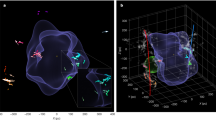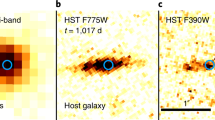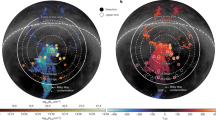Abstract
LARGE scale gas movements with velocities of the order of 50 km s−1 giving rise to split, asymmetric or broadened emission line profiles have been observed in many H II regions1–4. Proposed explanations for these motions include supernova explosions within or near to the H II regions5, and the acceleration of their ionised material by relativistic particles6 or by massive stellar winds7–9.I suggest that the breakup of the neutral gas and dust shell around a cocoon star could conceivably also produce high velocities. The existence of cocoon stars seems fairly well established from observations of infrared point sources10,11 and these are frequently associated with compact H II regions12 and OH masers. Kahn13 investigated the evolution of a cocoon star and found that a star which accretes matter will form a false photosphere with a radius of the order 1013 cm and no appreciable H II region, provided that the rate of accretion exceeds approximately 1020 g s−1. Around the false photosphere is a dust-free region with a radius of about 1016 cm, which corresponds to the radius at which refractory particles melt. At accretion rates of less than 1022 g s−1 the radiation pressure on the dust becomes powerful enough to stop the infall of matter and to drive a shock wave into the accreting gas flow outside a radius of 1016 cm. This situation is Rayleigh–Taylor unstable, and the shell will break up into globules. Consider a portion of neutral material with a density of M g cm−2, at a distance, R, from a star with mass, M*, and luminosity L* (M* ≈ 6 × 1034 g, L* ≈ 6 × 1038 erg s−1). If the radiation force just balances the gravitational force exerted by the star, then  Thus, M ≈ 0.7 g cm−2 independent of distance. This is very close to the surface density required by the models of Dyson14 (M ≃ 2 g cm−2) for which a great deal of observational evidence15,16 has been collected, particularly in the case of M8 and M42. It is thus possible that some of the globules represent the material that was just balanced by the radiation—gravitational forces, at the time of the breakup of the cocoon.
Thus, M ≈ 0.7 g cm−2 independent of distance. This is very close to the surface density required by the models of Dyson14 (M ≃ 2 g cm−2) for which a great deal of observational evidence15,16 has been collected, particularly in the case of M8 and M42. It is thus possible that some of the globules represent the material that was just balanced by the radiation—gravitational forces, at the time of the breakup of the cocoon.
This is a preview of subscription content, access via your institution
Access options
Subscribe to this journal
Receive 51 print issues and online access
$199.00 per year
only $3.90 per issue
Buy this article
- Purchase on Springer Link
- Instant access to full article PDF
Prices may be subject to local taxes which are calculated during checkout
Similar content being viewed by others
References
Sheglov, P. V., Astrophys. Lett., 1, 145 (1968).
Meaburn, J., Astrophys. Space Sci., 13, 110 (1971).
Smith, M. G., and Weedman, D. W., Astrophys. J., 169, 271 (1971).
Dopita, M. A., Gibbons, A. H., Meaburn, J., and Taylor, K., Astrophys. Lett., 13, 515 (1973).
Gershberg, R. E., and Sheglov, P. V., Soviet Astron., 8, 337 (1964).
Kahn, F. D., Q. Jl R. ast. Soc., 12, 384 (1971).
Pikelner, S. B., Astrophys. Lett., 2, 97 (1968).
Dyson, J. E., and de Vries, J., Astr. Astrophys., 20, 223 (1972).
Dyson, J. E., ibid., 23, 381 (1973).
Becklin, E. E., and Neugelbauer, G., Astrophys. J., 147, 799 (1967).
Wynn-Williams, C. G., Becklin, E. E., and Neugelbauer, G., Mon. Not. R. ast. Soc., 160, 1 (1972).
Habing, H. J., The Interstellar Medium (edit. by Pinkau K.), (Reidel, 1974).
Kahn, F. D., ibid.
Dyson, J. E., Astrophys. Space Sci., 1, 388 (1968).
Dopita, M. A., Dyson, J. E., and Meaburn, J., ibid., (in the press).
Elliott, K. H., and Meaburn, J., ibid. (in the press).
Author information
Authors and Affiliations
Rights and permissions
About this article
Cite this article
DOPITA, M. High velocities and cocoon stars. Nature 250, 397–398 (1974). https://doi.org/10.1038/250397a0
Received:
Issue Date:
DOI: https://doi.org/10.1038/250397a0
Comments
By submitting a comment you agree to abide by our Terms and Community Guidelines. If you find something abusive or that does not comply with our terms or guidelines please flag it as inappropriate.



